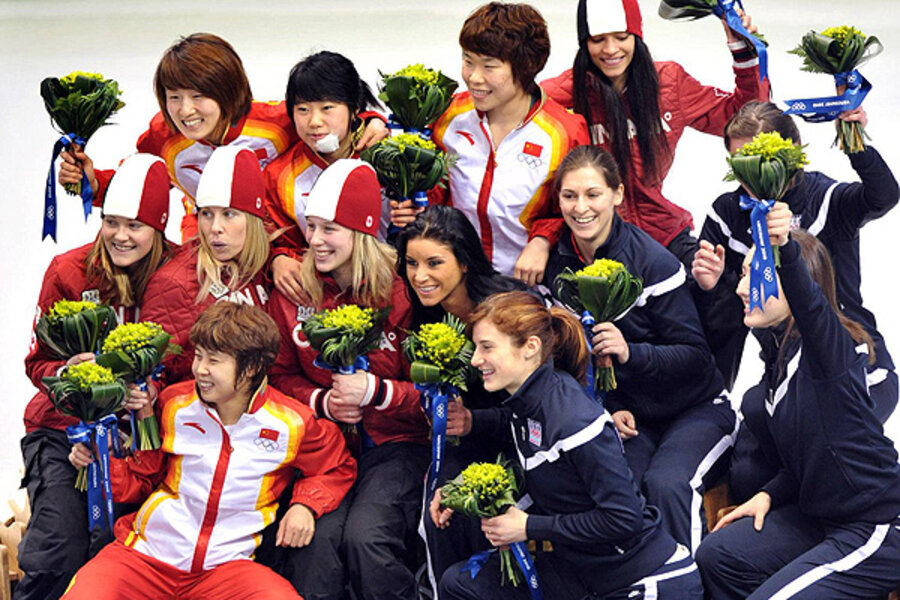USA, Canada ride new sports to top of Winter Olympics medal count
Loading...
| Vancouver, British Columbia
Wednesday night was the perfect example of how drastically the Winter Olympics have changed during the past 20 years.
In the three evening medal events, the medalists were from:
Canada, Canada, USA; China, Canada, USA; Australia, China, China.
Not a Germany or a Russia in the bunch.
The reason?
Each of the events contested Wednesday night has been added since 1992, when the International Olympic Committee began its quest to remake the Winter Olympics.
The first and most obvious step in this process was to move the Winter Games to a new four-year cycle, giving them breathing space from their summer cousin. But by far the more transformational step was to begin admitting events that would broaden the Winter Olympics beyond their traditional appeal to people who find lederhosen not at all peculiar.
Among the events added were those contested Wednesday night: women’s bobsled, short track speedskating, and freestyle aerials.
A revolution, by the numbers
From 1992 to 2006, the medal table for new, non-cross-country skiing-related events shows how complete the IOC’s success has been:
1. USA: 16-14-14 – 44
2. Canada: 13-17-12 – 42
3. South Korea: 17-7-5 – 29
4. China: 4-12-7 – 23
It is the single biggest reason that the US has won more Winter Olympic medals than any country except Germany during the past two Olympics. And it is why Canada even considered it possible to own the podium.
The new-sport medal table for the Vancouver Games is, if anything, even starker. In the events that have finished:
1. USA: 3-2-8 – 13
2. Canada: 5-5-0 – 10
3. China: 3-1-1 – 5
4. Korea: 2-2-1 – 5
5. Australia: 2-1-0 – 3
The Olympics have essentially become two different Olympics, with the US and Canada competing for supremacy in the new events, and Germany and Norway competing for supremacy in the traditional ones.
Of course, there is crossover, such as the US winning eight medals in alpine skiing. Meanwhile, the Europeans’ best “new” events – snowboard parallel giant slalom and curling – still lie ahead in Vancouver.
China's opportunity
But the shift has certainly reordered the winter sports world, with nations like China taking advantage.
Ahead of the Beijing Olympics, China found immediate success in investing massive sums of money into Summer Olympic sports, most of which have a wide geographical footprint but shallow roots. Breaking into the core sports of the traditional Winter Games, however, is far more difficult.
“The Winter Games are harder to crack, because there aren’t as many soft events,” says David Wallechinsky, author of “The Complete Book of the Winter Olympics." “These sports are deeply ingrained in certain cultures.”
“To say, ‘We can beat the Norwegians in cross-country,’ is saying a lot,” he says. “Some countries have been competing in these sports at a high level since before there were a Winter Olympics.”
But China has been able to find success in new sports.
Most obviously, Asia is to short track what Norway is to cross-country, giving countries like China and South Korea a natural advantage. And in aerials, China has been able to parlay its strong gymnastics heritage to a winter sport.
It is also trying to move into the so-called “weaker” new sports – where less competition exists. It has the No. 1-ranked women’s curling team, for example.
The US and Canada, by contrast, have gained supremacy in new sports by being able to have sustained success across a number of new sports.
In these Games, the US has won medals in women’s bobsled, moguls, short track, halfpipe snowboarding, and snowboardcross. The Canadian list is even more extensive, including skeleton and ski-cross (though not halfpipe).
Both are promised at least one more “new” medal.
They face off Thursday in the women’s hockey final, having once again pushed the Europeans aside. No other country has ever won gold in women’s hockey
Non-cross-country skiing-related events introduced since 1992 are in women's bobsled, curling, freestyle skiing (moguls, aerials, and now ski cross), women's hockey, short track speedskating, skeleton, snowboarding (halfpipe, giant slalom, and boardercross), and the long track speedskating (team event).
Here is a list of the 1992-2006 medal tables for the new sports that award the most medals:
Short track (introduced in 1992)
1. Korea: 17-7-5 – 29
2. Canada: 5-8-7 – 20
3. China: 3-10-7 – 20
4. USA: 4-3-5 – 12
Snowboarding (halfpipe and giant slalom* in 1998, boardercross in 2006)
1. USA: 5-4-5 – 14
2. Switzerland: 5-1-2 – 8
3. France: 2-2-1 – 5
Freestyle skiing (moguls in 1992 and aerials in 1994)
1. USA: 4-4-2 – 10
2. Norway: 2-1-3 – 6
3. France: 1-2-3 – 6
*The event was a timed giant slalom in 1998; in 2002 it became a race between two riders on parallel courses.
-----
Mark will blind you with more science on his Twitter feed and Facebook.





